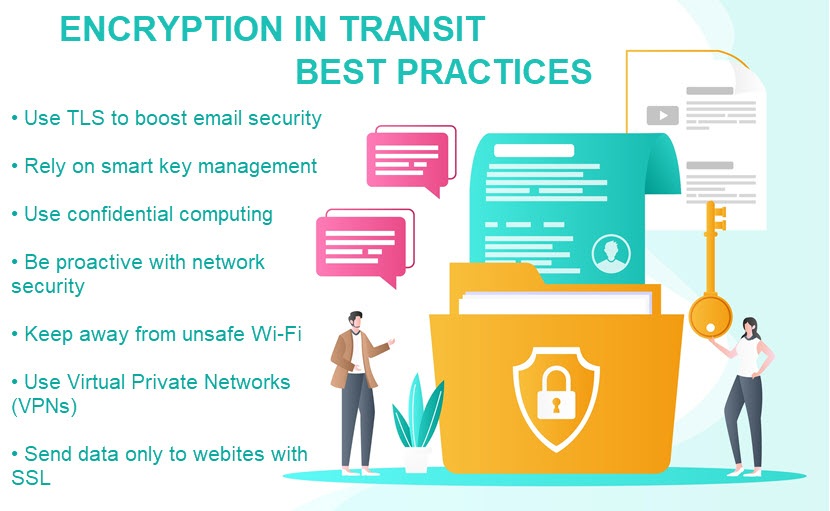In an age where digital communication dominates our interactions, the question arises: How secure is your data as it traverses the expansive cyber landscape? Encryption serves as the bulwark against potential breaches, safeguarding sensitive information that flows through myriad channels. But how exactly does encryption operate to protect your data in transit? Understanding this intricate process can illuminate the challenges and solutions facing data security.
At its core, encryption transforms plaintext into ciphertext, rendering it unreadable to unauthorized entities. This metamorphosis hinges on algorithms and keys. The algorithms dictate the process by which the data is transformed, ranging from symmetric encryption, where a single key is employed for both encryption and decryption, to asymmetric encryption, which utilizes a pair of keys—public and private. The choice of encryption method can significantly influence the level of security provided, as well as the efficiency of data transmission.
Data in transit refers to information actively moving from one location to another, whether across the internet, through a private network, or between two devices. This dynamic phase is particularly vulnerable to interception, which is where encryption plays a crucial role. By encrypting data during transmission, organizations can thwart potential eavesdroppers, who might lurk in the shadows of the digital realm.
When a user accesses a secure website, for instance, a secure protocol called TLS (Transport Layer Security) is often employed. TLS facilitates encrypted connections by creating a secure channel between the client and server. This is where the public and private keys come into play. The server presents its public key to the client, which then utilizes this key to encrypt data before transmitting it. Upon receipt, the server decrypts the information using its corresponding private key. This exchange exemplifies the dance of encryption, ensuring that even if data is intercepted, it remains concealed within a cryptographic cloak.
However, the implementation of encryption is not without its challenges. One potential hurdle is the balance between security and performance. Encryption algorithms, while robust, can consume significant computational resources. Consequently, organizations must consider the trade-offs between stringent security measures and the speed of data transmission. For instance, extensive encryption may introduce latency, affecting user experience. Organizations are thus compelled to refine their encryption strategies—optimizing algorithms, enhancing computational power, or even leveraging dedicated hardware for encryption tasks.
Moreover, key management emerges as another critical aspect of securing data in transit. The efficacy of encryption heavily relies on the protection of encryption keys. If a key is compromised, the data it encrypts becomes vulnerable, akin to providing an intruder with the keys to your digital fortress. Therefore, organizations must adopt stringent key management practices, encompassing generation, distribution, storage, rotation, and revocation. Utilizing software solutions that automate these processes can mitigate human error and bolster security.
Yet, the need for encryption extends beyond the confines of organizational data; it also extends to individual users. Consider the advent of end-to-end encryption, a paradigm often associated with messaging platforms. This approach ensures that only the communicating users can read the messages, with service providers unable to access the decrypted content. It poses a dual-edged sword: while it enhances user privacy, it also complicates law enforcement’s ability to intercept potentially malicious communications. Such complexities underscore the ongoing debate surrounding privacy and security in the digital age.
As we grapple with these multifaceted challenges, the role of encryption remains paramount. However, emerging threats necessitate continuous evolution. Cybercriminals are becoming increasingly sophisticated, often deploying advanced techniques such as man-in-the-middle attacks to intercept data in transit. To combat these nefarious tactics, organizations are exploring the integration of multi-layered security protocols, including tokenization and VPNs (Virtual Private Networks). Tokenization substitutes sensitive data with unique identification symbols, rendering it useless if intercepted, while VPNs create secure tunnels for data transmission, further cloaking the information from prying eyes.
Encryption is not merely a technical necessity; it embodies a fundamental principle of trust in the digital era. As users, the assurance that our data is shielded from unscrupulous actors empowers us to navigate the vast online expanse with confidence. Nonetheless, this trust is contingent upon the diligent application of encryption practices and the constant vigilance against emerging threats.
The landscape of digital security is perpetually shifting. As technology advances, so too do the strategies employed by both defenders and adversaries. Organizations must remain proactive, engaging in continual risk assessments and updating their encryption protocols accordingly. Partnerships with cybersecurity experts can provide invaluable insights into the evolving threat landscape, equipping organizations with the tools necessary to fortify their defenses.
In conclusion, encryption is an indispensable mechanism for securing data in transit. While it faces challenges related to performance, key management, and the dualities of privacy and security, its importance cannot be overstated. By understanding the intricacies of encryption and its implications for data protection, individuals and organizations alike can cultivate a safer digital environment. It beckons the question: Are you taking the necessary steps to secure your digital communications, or are you inadvertently leaving the door ajar for potential intruders? Each click, each message, is a thread in the tapestry of our interconnected lives—let’s weave it with care.








Leave a Comment